 | | Knowledge |   |
Agate4u.com (Agate for You)
What Is Agate ?
If you ask 12 different people this question you will probably get twelve different answers, and to be honest they would all probably be correct to some degree.
So for the purists first of all - Agate is a form Chalcedony which in turn is a form of quartz (silicon dioxide).
Now, for the rest of us mere mortals, let me explain in simple English.
Pure quartz is clear, like glass, which is of course why glass is clear - because it is made of sand, which is basically nothing more than ground up and broken down quartz crystals.
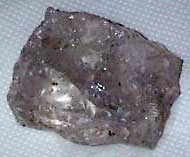 Here is a piece or rough natural quartz. It looks like a piece of glass. Its general appearance is clear like a piece of glass, although this piece has quite a number of fractures within the rock. This piece is from North Wales. If this lump of quartz had been in the sea, and you had found it on the beach the resulting pebble would resemble a piece of glass. Quartz is silicon dioxide.
Here is a piece or rough natural quartz. It looks like a piece of glass. Its general appearance is clear like a piece of glass, although this piece has quite a number of fractures within the rock. This piece is from North Wales. If this lump of quartz had been in the sea, and you had found it on the beach the resulting pebble would resemble a piece of glass. Quartz is silicon dioxide.
|
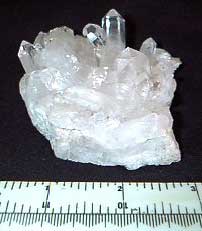 Here is a sample of a quartz crystal bed. This piece came from Brazil. As can be seen from the photograph that the bottom of the bed is a milky colour, and sticking out of the top are a number of clear quartz crystal points or wands. This shows us the shape and structure of the quartz crystals. The question is - why in this example is the bottom half of the sample milky and the top half clear? The answer is - because of impurities.
Here is a sample of a quartz crystal bed. This piece came from Brazil. As can be seen from the photograph that the bottom of the bed is a milky colour, and sticking out of the top are a number of clear quartz crystal points or wands. This shows us the shape and structure of the quartz crystals. The question is - why in this example is the bottom half of the sample milky and the top half clear? The answer is - because of impurities.
|
If some other substance, mineral or chemical got mixed with the pure quartz either when it was originally being formed or afterwards in a metamorphic process, the colour and consistency of the pure natural quartz was changed according to what the substance, mineral or chemical was that got mixed with it.
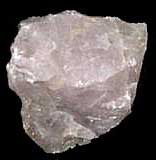 Here is a piece of Rose Quartz. This piece came from Brazil. It is roughly the same size and shape of the piece of clear quartz above. But it has changed colour from being clear like glass to being semitransparent and pink. This colour change is caused by another substance or chemical being present when the rock was being formed. It is still classed as Quartz, but is given the classification "Rose Quartz" because of this colour change.
Here is a piece of Rose Quartz. This piece came from Brazil. It is roughly the same size and shape of the piece of clear quartz above. But it has changed colour from being clear like glass to being semitransparent and pink. This colour change is caused by another substance or chemical being present when the rock was being formed. It is still classed as Quartz, but is given the classification "Rose Quartz" because of this colour change.
|
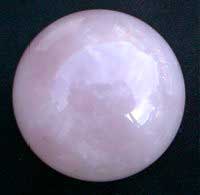 Here is a sphere which has been cut, ground and polished out of a piece of Rose Quartz. People like Rose Quartz because of its pink colour, and indeed it is very nice and pleasing. When it has been well prepared and polished it is just like holding a pink glass ball. The cloud formation within the sphere which varies from transparent to semitransparent and translucent all adds to the beauty of the object. A clear Quartz sphere, whilst pure, is somewhat boring. A coloured Quartz sphere is more interesting.
Here is a sphere which has been cut, ground and polished out of a piece of Rose Quartz. People like Rose Quartz because of its pink colour, and indeed it is very nice and pleasing. When it has been well prepared and polished it is just like holding a pink glass ball. The cloud formation within the sphere which varies from transparent to semitransparent and translucent all adds to the beauty of the object. A clear Quartz sphere, whilst pure, is somewhat boring. A coloured Quartz sphere is more interesting.
|
So the first lesson that we learn is that even though the pure Quartz has been contaminated with an impurity, it is in fact because of the impurity itself that the new blend of rock is made more pleasing to the eye and the senses.
What has all of this got to do with Agate?
In order to classify the different types of rocks and minerals they have been given different names. They may, in their structure and chemical composition be very similar to Quartz with just a single impurity or a multiple set of impurities, and depending on the impurity present we give them a different name to identify them. They are also reclassified and given a different name if the original quartz was melted by volcanic activity and reconstituted in a slightly different form, so now we move on to a group of rocks and minerals which are given the name - Chalcedony (pronounced Cal-sed-ony).
Chalcedony is the family name for a whole range of rocks and the range is vast. Chalcedony is a type of Quartz. It is cryptocrystalline Quartz to be exact. It is Quartz that has been changed due to either some other chemical constituent being present or a metamorphic change due to heat from a source such as volcanic activity or a combination of both.
Chalcedony therefore is the group or family name which has been given so that we can identify a whole range of cryptocrystalline Quartz minerals.
Agate is a type of Chalcedony.
But let us start at the bottom and work our way up.
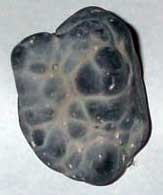 This is a piece of Chalcedony, and it is about as natural and pure as you can get. This piece is grey / green in colour and as can be seen by the photograph it looks like a bunch of bubbles. These bubbles are the result and proof of volcanic activity, It is presumed that they were formed as a result of the original Quartz being melted by volcanic activity, mixed with volcanic gas, and the resulting mineral soup being forced into fissures and cavities within the surrounding molten or semi-molten rock. This piece of Chalcedony came from North Wales. Because of the way that it was formed and the constituents of Chalcedony it has a waxy feel and appearance.
This is a piece of Chalcedony, and it is about as natural and pure as you can get. This piece is grey / green in colour and as can be seen by the photograph it looks like a bunch of bubbles. These bubbles are the result and proof of volcanic activity, It is presumed that they were formed as a result of the original Quartz being melted by volcanic activity, mixed with volcanic gas, and the resulting mineral soup being forced into fissures and cavities within the surrounding molten or semi-molten rock. This piece of Chalcedony came from North Wales. Because of the way that it was formed and the constituents of Chalcedony it has a waxy feel and appearance.
|
Chalcedony comes in many different colours. It can be red, white, blue, green, brown, purple, pink, black and just about every other colour imaginable, and depending on the colour it is given a different name so that we can classify it.
 If it is pale green or sometimes blue it is called Chrysoprase. This is considered by collectors to be one of the more valuable types of Chalcedony. It polishes beautifully. Here is a piece of water washed Chrysoprase.
If it is pale green or sometimes blue it is called Chrysoprase. This is considered by collectors to be one of the more valuable types of Chalcedony. It polishes beautifully. Here is a piece of water washed Chrysoprase.
|
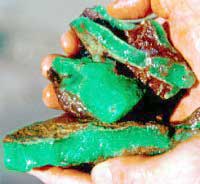 Chrysoprase is very often found in slab form. As can be seen by the picture it is a very waxy looking rock. This dense waxiness is one of the pointers to Chalcedony and the other minerals associated with it.
Chrysoprase is very often found in slab form. As can be seen by the picture it is a very waxy looking rock. This dense waxiness is one of the pointers to Chalcedony and the other minerals associated with it.
|
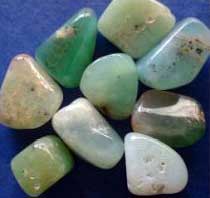 The picture on the left is of a bunch of tumbled Chrysoprase pebbles. Chrysoprase can be deep green like the picture above, but it can also be pale green, blue or quite a number of intermediate associated colours.
The picture on the left is of a bunch of tumbled Chrysoprase pebbles. Chrysoprase can be deep green like the picture above, but it can also be pale green, blue or quite a number of intermediate associated colours.
|
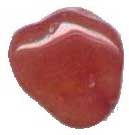 If the colour of the Chalcedony is red it is called Carnelian. This is another sought after type. It is very often found as either a major stone or shoulder stones in semi precious jewelry.
If the colour of the Chalcedony is red it is called Carnelian. This is another sought after type. It is very often found as either a major stone or shoulder stones in semi precious jewelry.
|
Are therefore the two examples of Chalcedony that we have looked at (Chrysoprase and Carnelian) to be classed as Agate? Oh dear, this is where the purist academics start hurling rocks and abuse at one another. It is a bit like the argument over the difference between Flint and Chert. They seem to get a buzz out of arguing for the sake of it, and I am too old to be bothered with the sheer and utter nonsense of it all. Let me show you how stupid this argument is and then you can make up your own mind.
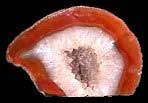 Everybody in the industry, even the purists are happy and content to classify the rock in the picture to the left as Agate. It is an Agate Geode with a Quartz crystal centre.
Everybody in the industry, even the purists are happy and content to classify the rock in the picture to the left as Agate. It is an Agate Geode with a Quartz crystal centre.
|
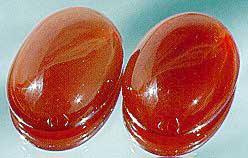 They are also very happy and content to call the polished stones in the picture to the left - "Carnelians".
They are also very happy and content to call the polished stones in the picture to the left - "Carnelians".
|
Now, the question is - If I get a diamond saw, and cut out of the Agate rock on the left a portion of the red banding and then cut it into a cabochon and polish it into mountable stones like those on the right, will the purists who have insisted that there is a difference between Agate and Carnelian call the new piece of red stone Agate or Carnelian?
They will call it Carnelian!
This is why I have absolutely no time or patience for the stupid arguments. So you make up your own mind and do not bother emailing me to tell me how I am missing the point. I have heard it all before.
So, to continue and to try and bring some sense into this insanity - Carnelian is a type of Chalcedony. Carnelian is the name that we give to identify the red form of Chalcedony.
Agate is also a form of Chalcedony. And red Agate is cut and polished and marketed as Carnelian all over the world.
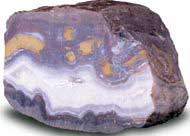 The thing which most people will associate with Agate are its very often beautiful forms of pattern as the sample on the left shows.
The thing which most people will associate with Agate are its very often beautiful forms of pattern as the sample on the left shows.
There are many forms of Agate. It can be found as massive outcrops or as nodules.
|
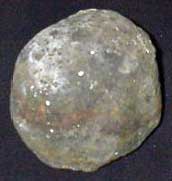 As far as the nodules are concerned, just think of the piece of Chalcedony pictured above which was like a mass of bubbles stuck together and think of an Agate nodule as a single bubble. Here is a natural Agate nodule just as it was collected from Mother earth. It is roughly spherical in shape like a bubble. From experience, I know that this one is going to have a red or deep orange outer layer just underneath that horrible grey rock, but that is about all that I know. When it is cut open I may find that it is red all the way through, or I may discover that it consists of a range of patterns deep within the interior which are visually staggering to the senses. These bands of colour can at times be quite amazing. And depending on the format of the banding it is classified with a different name.
As far as the nodules are concerned, just think of the piece of Chalcedony pictured above which was like a mass of bubbles stuck together and think of an Agate nodule as a single bubble. Here is a natural Agate nodule just as it was collected from Mother earth. It is roughly spherical in shape like a bubble. From experience, I know that this one is going to have a red or deep orange outer layer just underneath that horrible grey rock, but that is about all that I know. When it is cut open I may find that it is red all the way through, or I may discover that it consists of a range of patterns deep within the interior which are visually staggering to the senses. These bands of colour can at times be quite amazing. And depending on the format of the banding it is classified with a different name.
|
 If the colored bands of Chalcedony are formed in sharp angled geometric shapes similar to the one in the picture to the left the example is called Fortification Agate. It is called "Fortification Agate" because the shape of the bands resemble an old style fortress with its angled walls.
If the colored bands of Chalcedony are formed in sharp angled geometric shapes similar to the one in the picture to the left the example is called Fortification Agate. It is called "Fortification Agate" because the shape of the bands resemble an old style fortress with its angled walls.
|
 If the layers of Chalcedony are in thin curved bands which do not have a particular geometric shape or pattern it is simply called Banded Agate. These are most commonly seen in geodes or nodules.
If the layers of Chalcedony are in thin curved bands which do not have a particular geometric shape or pattern it is simply called Banded Agate. These are most commonly seen in geodes or nodules.
|
Although nothing is certain in this life, especially where nature is concerned, a general rule of thumb is that nodules tend to produce the fine banded and fortification type agates. The small confined space in which they were formed seems to be the factor which determines that the bandings are close together.
If there was a lot of space to fill in the original cavity and a lot of cryptocrystalline Quartz to fill the cavity then the massive lump of Chalcedony which was produced tends to be much more of a single colour, or the pattern within the rock is more open and random.
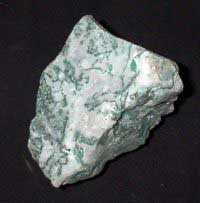 Here is a piece of rough Chalcedony / Agate which comes under the general classification of "Tree Agate". It is agate, but it does not display the banding of the banded variety. The pattern is much more open, random and loose. There is no uniformity to it. This is quite a nice example because the green bits are a good distance apart, so when it is polished into a sphere it will be pleasing to the eye.
Here is a piece of rough Chalcedony / Agate which comes under the general classification of "Tree Agate". It is agate, but it does not display the banding of the banded variety. The pattern is much more open, random and loose. There is no uniformity to it. This is quite a nice example because the green bits are a good distance apart, so when it is polished into a sphere it will be pleasing to the eye.
|
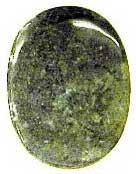 Here is a polished cabochon of another type of agate. This example is a mixture of different shades of green. Because of its appearance which looks like small patches or moss. It is generally referred to as "Moss Agate".
Here is a polished cabochon of another type of agate. This example is a mixture of different shades of green. Because of its appearance which looks like small patches or moss. It is generally referred to as "Moss Agate".
|
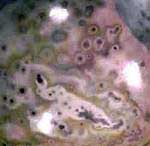 Agate can be found in many different colours and forms. This fine specimen is light gray with very pale lavender-pink colours. It has small bull's-eye like patterns in it. It is often referred to as "Bulls Eye Agate".
Agate can be found in many different colours and forms. This fine specimen is light gray with very pale lavender-pink colours. It has small bull's-eye like patterns in it. It is often referred to as "Bulls Eye Agate".
|
And now we come to one of the most well known forms of Chalcedony which also falls under the classification of Agate - It is called Onyx. Oh dear what a nightmare!
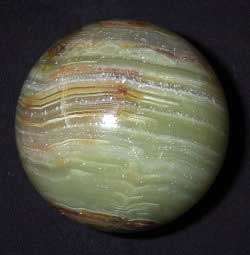 This rock which has been, and still is being marketed all over the world as Onyx, usually as an import from Pakistan, is NOT onyx!
This rock which has been, and still is being marketed all over the world as Onyx, usually as an import from Pakistan, is NOT onyx!
It is a very beautiful banded rock in its own right and we cut and polish a lot of it, because at times the figuring is quite stunning and sometimes every bit as good as Crazy Lace Agate. But it isn't Onyx, neither is it an Agate and should not be classified as such. It is a type of Calcite, much softer than Onyx, and whilst it is very beautiful, it has done the true Onyx industry a lot of harm.
|
The gift shops of the world are full of tables, ash trays, lamp standards, vases and all manner of decorative items made from this rock and they are sold as Onyx. THEY ARE NOT ONYX! The problem is - it has been going on for so long that now the general buying public and even many mineral dealers think that they know what Onyx is and what it looks like.
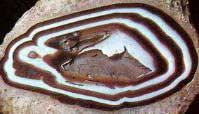 This is an example of real Onyx. In this case it is a brown and white striped variety, but it can consist of black and white stripes and sometimes blue or green and white stripes.
This is an example of real Onyx. In this case it is a brown and white striped variety, but it can consist of black and white stripes and sometimes blue or green and white stripes.
|
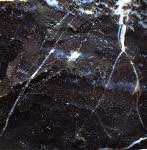 Here is another example of a piece of rough Onyx. This example is mainly black with white veins. It is a very hard rock, it polishes beautifully and has a depth of colour quite unlike anything else.
Here is another example of a piece of rough Onyx. This example is mainly black with white veins. It is a very hard rock, it polishes beautifully and has a depth of colour quite unlike anything else.
|
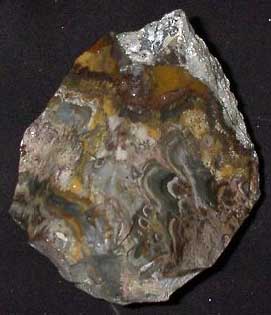 And here is a piece of rough rock which contains a whole host of Chalcedony material. It is called "Crazy Lace" Agate. It is a very beautiful and sought after mineral. The totally random patterning and host of different colours and swirls means that there is always something to admire and look at. The white peak to the top of the picture is quartz. Just let your imagination run wild and try to imagine what this would look like polished into a sphere.
And here is a piece of rough rock which contains a whole host of Chalcedony material. It is called "Crazy Lace" Agate. It is a very beautiful and sought after mineral. The totally random patterning and host of different colours and swirls means that there is always something to admire and look at. The white peak to the top of the picture is quartz. Just let your imagination run wild and try to imagine what this would look like polished into a sphere.
|
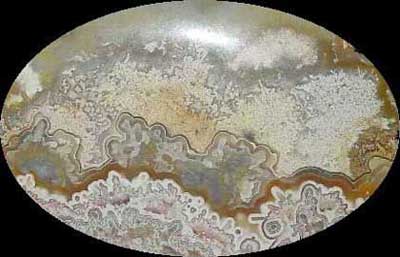 And to give you an idea of what Crazy Lace Agate looks like, here is an oval cabochon which was cut from the edge of a piece of rock similar to the one above.
And to give you an idea of what Crazy Lace Agate looks like, here is an oval cabochon which was cut from the edge of a piece of rock similar to the one above.
|
So, Chalcedony is a type of Quartz. It is cryptocrystalline Quartz to be exact. If other chemical constituents are present in the Quartz, it is given a different name for ease of mineral identification. Chalcedony is a group name for a range of Quartz minerals which have been discoloured by other chemicals being present when it was formed.
Agate is a form of Chalcedony. Unlike normal quartz, it is made up of microscopically fine fibrous crystals, and it very often shows colour banding, stripes, whirls, bull's eye patterns or totally random patterns. It can be nearly transparent, but is usually translucent or opaque. In all truth, Agate does not have any true colour of its own - when it is pure it is grey or white. But it is a porous rock and very easily absorbs natural colours from substances dissolved in the area around it during its formation.
|
|

